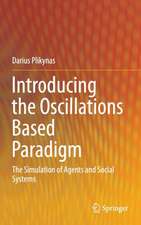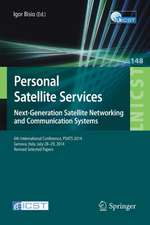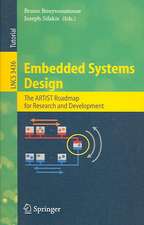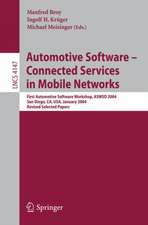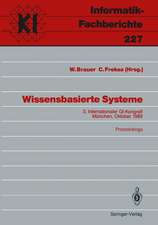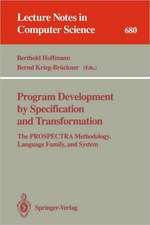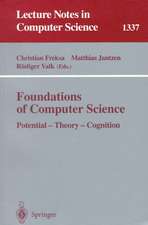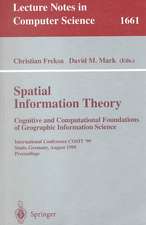Spatial Cognition IV, Reasoning, Action, Interaction: International Spatial Cognition 2004, Frauenchiemsee, Germany, October 11-13, 2004, Revised Selected Papers: Lecture Notes in Computer Science, cartea 3343
Editat de Christian Freksa, Markus Knauff, Bernd Krieg-Brückner, Bernhard Nebel, Thomas Barkowskyen Limba Engleză Paperback – mar 2005
Din seria Lecture Notes in Computer Science
- 20%
 Preț: 1040.03 lei
Preț: 1040.03 lei - 20%
 Preț: 333.46 lei
Preț: 333.46 lei - 20%
 Preț: 335.08 lei
Preț: 335.08 lei - 20%
 Preț: 444.17 lei
Preț: 444.17 lei - 20%
 Preț: 238.01 lei
Preț: 238.01 lei - 20%
 Preț: 333.46 lei
Preț: 333.46 lei - 20%
 Preț: 438.69 lei
Preț: 438.69 lei -
 Preț: 440.52 lei
Preț: 440.52 lei - 20%
 Preț: 336.71 lei
Preț: 336.71 lei - 20%
 Preț: 148.66 lei
Preț: 148.66 lei - 20%
 Preț: 310.26 lei
Preț: 310.26 lei - 20%
 Preț: 567.60 lei
Preț: 567.60 lei - 20%
 Preț: 571.63 lei
Preț: 571.63 lei - 15%
 Preț: 568.74 lei
Preț: 568.74 lei - 17%
 Preț: 427.22 lei
Preț: 427.22 lei - 20%
 Preț: 641.78 lei
Preț: 641.78 lei - 20%
 Preț: 307.71 lei
Preț: 307.71 lei - 20%
 Preț: 574.05 lei
Preț: 574.05 lei - 20%
 Preț: 579.56 lei
Preț: 579.56 lei -
 Preț: 373.56 lei
Preț: 373.56 lei - 20%
 Preț: 330.23 lei
Preț: 330.23 lei - 20%
 Preț: 649.49 lei
Preț: 649.49 lei - 20%
 Preț: 607.39 lei
Preț: 607.39 lei - 20%
 Preț: 538.29 lei
Preț: 538.29 lei - 20%
 Preț: 1386.07 lei
Preț: 1386.07 lei - 20%
 Preț: 326.98 lei
Preț: 326.98 lei - 20%
 Preț: 1003.66 lei
Preț: 1003.66 lei - 20%
 Preț: 256.27 lei
Preț: 256.27 lei - 20%
 Preț: 632.22 lei
Preț: 632.22 lei - 20%
 Preț: 575.48 lei
Preț: 575.48 lei - 20%
 Preț: 747.79 lei
Preț: 747.79 lei - 20%
 Preț: 1053.45 lei
Preț: 1053.45 lei - 17%
 Preț: 360.19 lei
Preț: 360.19 lei - 20%
 Preț: 504.57 lei
Preț: 504.57 lei - 20%
 Preț: 172.69 lei
Preț: 172.69 lei - 20%
 Preț: 369.12 lei
Preț: 369.12 lei - 20%
 Preț: 346.40 lei
Preț: 346.40 lei - 20%
 Preț: 809.19 lei
Preț: 809.19 lei -
 Preț: 402.62 lei
Preț: 402.62 lei - 20%
 Preț: 584.40 lei
Preț: 584.40 lei - 20%
 Preț: 1159.14 lei
Preț: 1159.14 lei - 20%
 Preț: 747.79 lei
Preț: 747.79 lei -
 Preț: 389.48 lei
Preț: 389.48 lei - 20%
 Preț: 343.16 lei
Preț: 343.16 lei - 20%
 Preț: 309.90 lei
Preț: 309.90 lei - 20%
 Preț: 122.89 lei
Preț: 122.89 lei
Preț: 661.51 lei
Preț vechi: 826.89 lei
-20% Nou
Puncte Express: 992
Preț estimativ în valută:
126.64€ • 131.83$ • 104.25£
126.64€ • 131.83$ • 104.25£
Carte tipărită la comandă
Livrare economică 31 ianuarie-14 februarie 25
Preluare comenzi: 021 569.72.76
Specificații
ISBN-13: 9783540250487
ISBN-10: 3540250484
Pagini: 540
Ilustrații: XIII, 519 p.
Dimensiuni: 155 x 235 x 28 mm
Greutate: 1.23 kg
Ediția:2005
Editura: Springer Berlin, Heidelberg
Colecția Springer
Seriile Lecture Notes in Computer Science, Lecture Notes in Artificial Intelligence
Locul publicării:Berlin, Heidelberg, Germany
ISBN-10: 3540250484
Pagini: 540
Ilustrații: XIII, 519 p.
Dimensiuni: 155 x 235 x 28 mm
Greutate: 1.23 kg
Ediția:2005
Editura: Springer Berlin, Heidelberg
Colecția Springer
Seriile Lecture Notes in Computer Science, Lecture Notes in Artificial Intelligence
Locul publicării:Berlin, Heidelberg, Germany
Public țintă
ResearchCuprins
Route Directions, Wayfinding, and Spatial Behavior.- Finding the Way Inside: Linking Architectural Design Analysis and Cognitive Processes.- Modelling Wayfinding in Public Transport: Network Space and Scene Space.- Isovists as a Means to Predict Spatial Experience and Behavior.- A Model for Context-Specific Route Directions.- Investigation of Preference Between the Least-Angle Strategy and the Initial Segment Strategy for Route Selection in Unknown Environments.- Descriptions of Space – Prepositions and Reference.- Spatial Prepositions and Vague Quantifiers: Implementing the Functional Geometric Framework.- Reference Frame Conflict in Assigning Direction to Space.- Identifying Objects on the Basis of Spatial Contrast: An Empirical Study.- Cultural Differences of Spatial Descriptions in Tourist Guidebooks.- Mental Models, Diagrams, and Maps.- Reasoning About Consistency with Spatial Mental Models: Hidden and Obvious Indeterminacy in Spatial Descriptions.- Spatial Principles in Control of Focus in Reasoning with Mental Representations, Images, and Diagrams.- Perceptually Induced Distortions in Cognitive Maps.- Characterizing Diagrams Produced by Individuals and Dyads.- Sketch Map Analysis Using GIS Buffer Operation.- Imagined Perspective–Changing Within and Across Novel Environments.- Thinking Through Diagrams: Discovery in Game Playing.- Spatio-Temporal Representation and Reasoning.- The Finest of its Class: The Natural Point-Based Ternary Calculus for Qualitative Spatial Reasoning.- Exploiting Qualitative Spatial Neighborhoods in the Situation Calculus.- Branching Allen.- SNAPVis and SPANVis: Ontologies for Recognizing Variable Vista Spatial Environments.- Modelling Models of Robot Navigation Using Formal Spatial Ontology.- Specification of an Ontology forRoute Graphs.- Robot Mapping and Piloting.- Autonomous Construction of Hierarchical Voronoi-Based Route Graph Representations.- Using 2D and 3D Landmarks to Solve the Correspondence Problem in Cognitive Robot Mapping.- Treemap: An O(log n) Algorithm for Simultaneous Localization and Mapping.- Towards Dialogue Based Shared Control of Navigating Robots.- Perception and Tracking of Dynamic Objects for Optimization of Avoidance Strategies in Autonomous Piloting of Vehicles.






